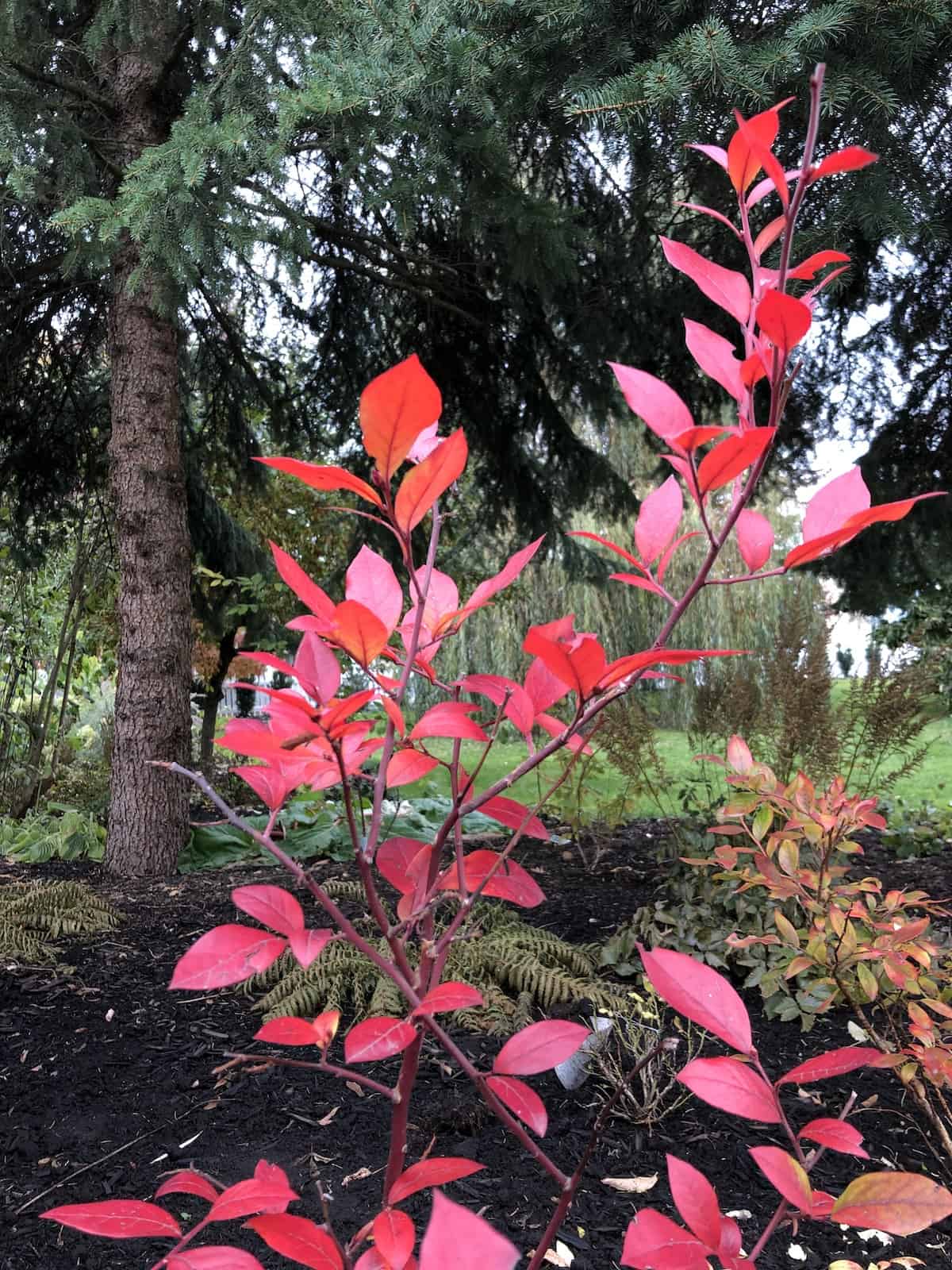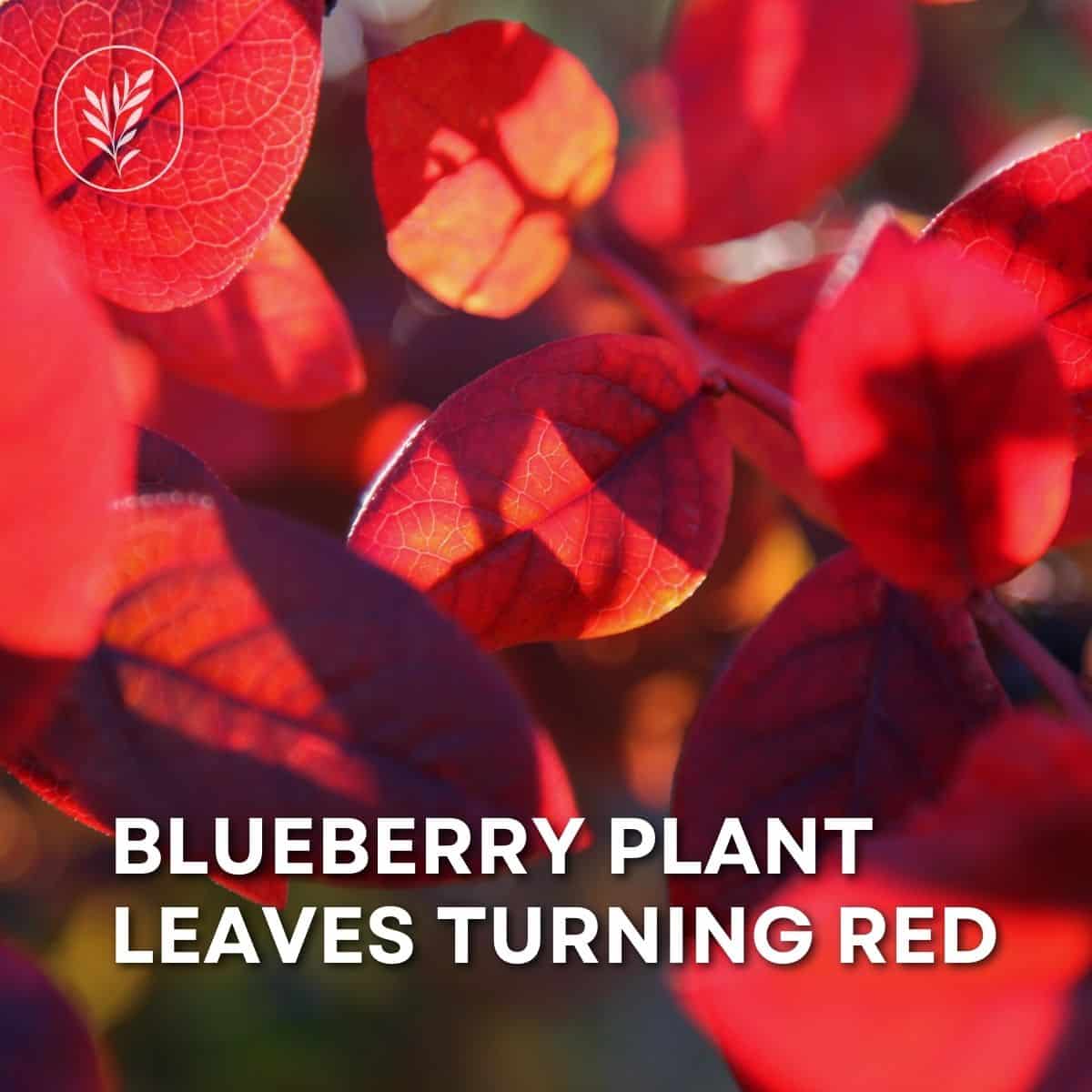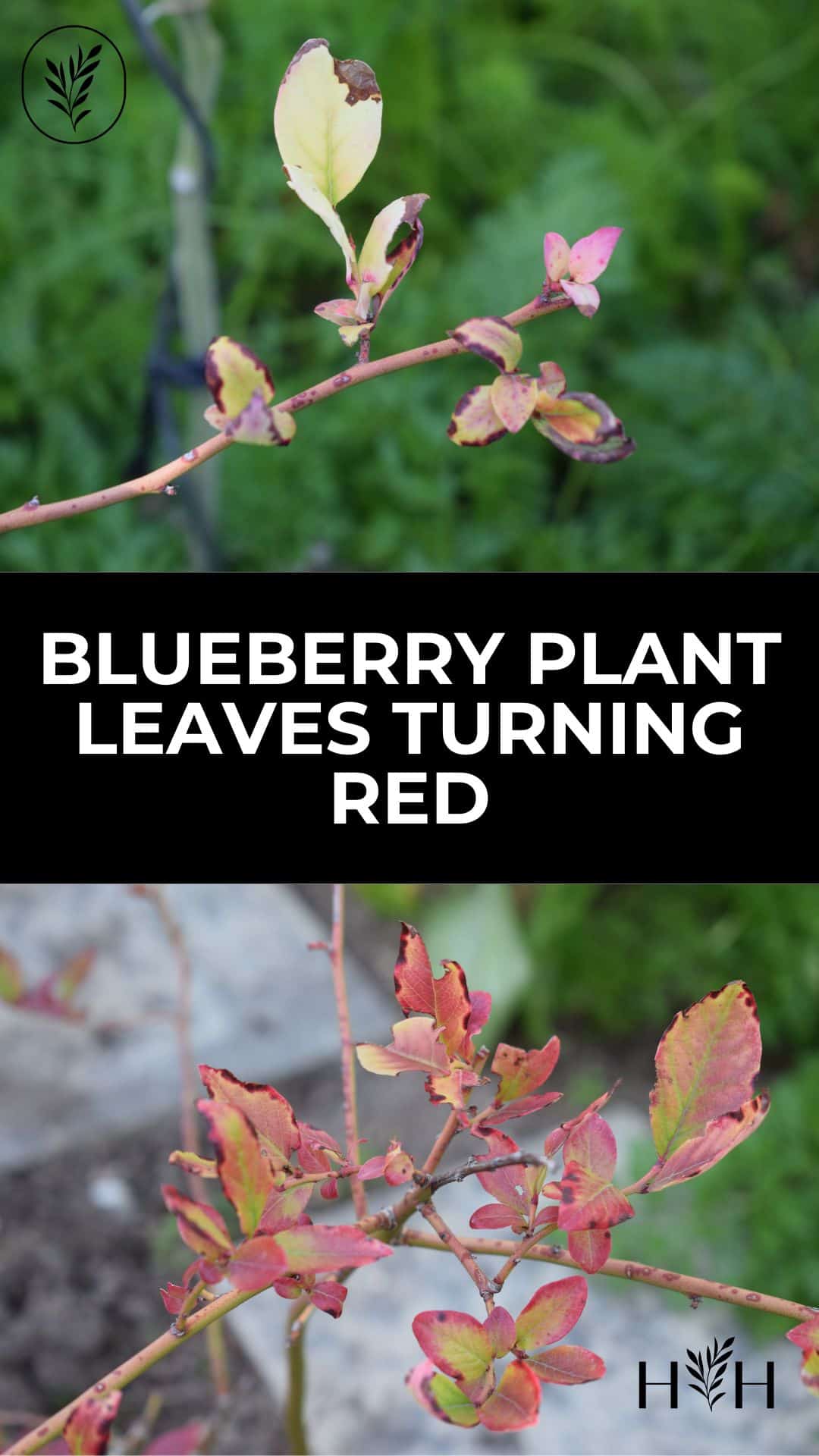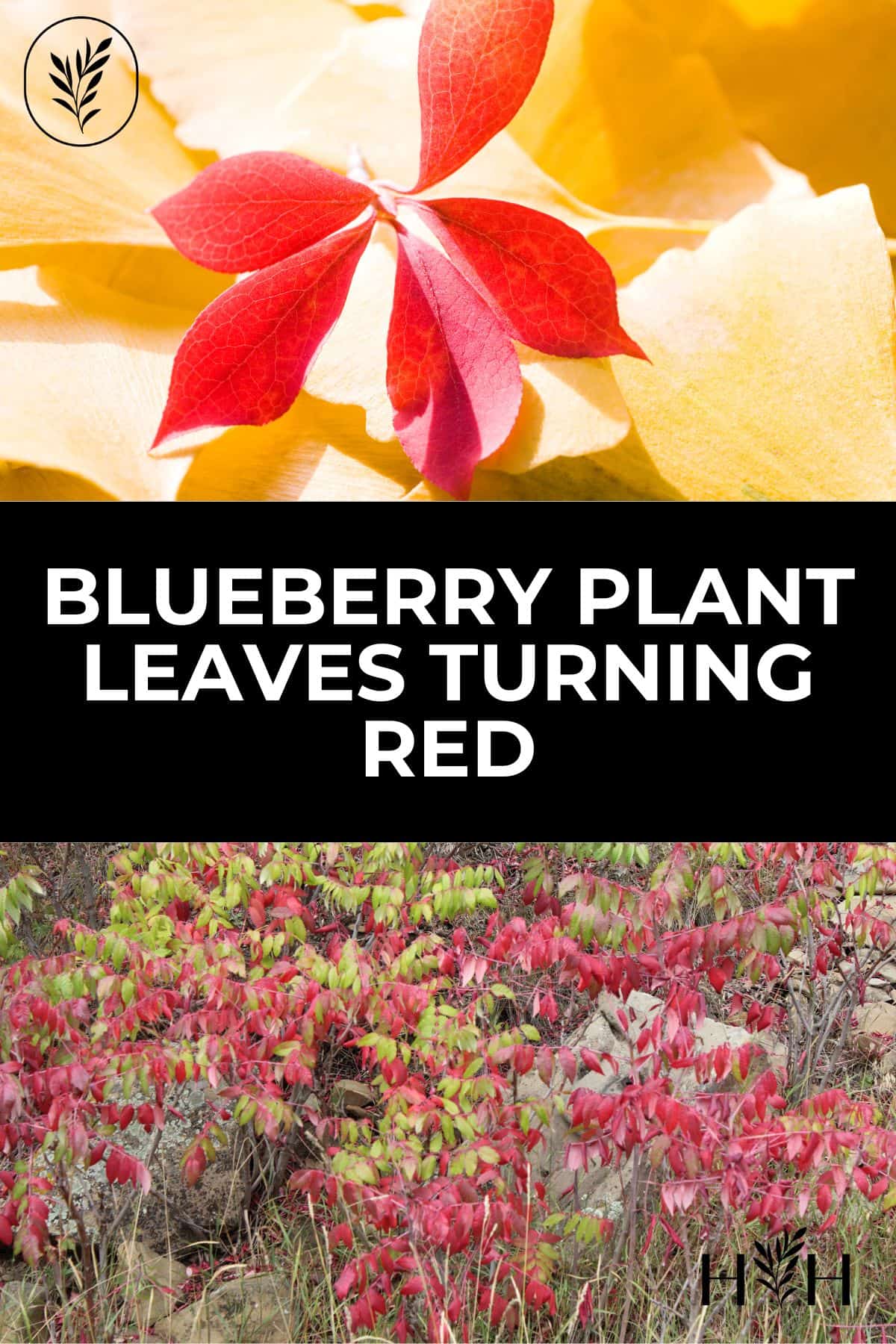Are you seeing red? It’s not a bad thing if it’s on your blueberry plant leaves. Red foliage can be a sign of health and vitality, but when it turns brown or yellow, something may be wrong.
If your blueberry plants have been showing signs of distress with their leaves turning red, then don’t panic – there are many potential causes that we will explore in this blog post. From normal behavior to nutrient deficiencies to environmental stressors and disease or pest infestations, let’s investigate the why behind those beautiful yet concerning red leaves on our beloved blueberry plants.
Causes of red leaves on blueberry plants
The most common cause of red leaves on blueberry plants is the arrival of autumn. Blueberry leaves naturally turn red in the fall as the plant retrieves its nutrients from the leaves and stores them for winter time. If your blueberry plant is showing red leaves at the same time that the nights are getting cooler and the days are getting shorter, it is likely normal behavior.
Non-normal red leaves on blueberry plants can be caused by a variety of factors. Nutrient deficiencies are one of the most common causes, as blueberries require specific nutrients to thrive. When the required nutrients are not present in the soil, it can result in the yellowing or slight reddening of the leaves. Common nutrient deficiencies that lead to red leaves include nitrogen, phosphorus, and potassium. Additionally, iron deficiency is often seen in blueberry plants with red foliage.
Environmental stress is another potential cause of red leaves on blueberry plants. Too much direct sunlight or too little water can lead to discoloration and damage to the foliage, resulting in a reddish hue due to a lack of chlorophyll production from inadequate light exposure or dehydration from drought-like conditions.
Understanding the underlying causes of red leaves on blueberry plants can help you diagnose the problem and take appropriate steps to address it. Let’s delve into the intricacies of discerning the source of red foliage on blueberry shrubs.
Diagnosing the problem
Considering the potential cause of blueberry foliage turning red, there are a few elements to contemplate. (Assuming its not autumn,) first, check the plant’s environment. Is it in an area that gets too much sun or not enough? Too much water or not enough? Are temperatures fluctuating drastically from day to night? All of these environmental factors can contribute to leaf discoloration and should be addressed if necessary.
Next, look for signs of disease or pests. Do you see any spots on the leaves or stems? Is there any webbing around the base of the plant or between branches? These could indicate fungal diseases like anthracnose and spider mites respectively. Should you spot any webbing, acting fast with fungicides and insecticides may be essential to stop the spread of anthracnose or spider mites through your garden?
Finally, examine your soil quality closely for nutrient deficiencies such as nitrogen deficiency which is often indicated by yellowing foliage at first followed by reddening later on in its progression. You can also test your soil pH levels with a simple kit available at most home improvement stores; blueberries prefer acidic soils, so make sure yours falls within this range before planting them next season. The plant can’t absorb certain nutrients (even if they are present) if the soil is to alkaline.
If none of these issues appear to be present then it might just be the natural aging process causing some older leaves to turn red during their final stages before falling off – nothing wrong here. If all else is unsuccessful, a gardening specialist in the vicinity can be consulted for customized advice that suits your unique circumstances.
Realizing the signs of nutrient inadequacy in blueberry plants is essential for taking the correct remedial measures to guarantee their prosperity.
Treating nutrient deficiencies
Nutrient deficiencies can cause red leaves on blueberry plants, but luckily they are easy to treat. The first step is to determine which nutrient the plant is lacking. This can be done by testing the soil or examining the leaves for signs of deficiency. If yellowing between veins is present, it could be a sign of nitrogen insufficiency; if there are spots and streaks on the leaves, this might point to an iron or manganese deficiency; while pale green patches on fresh growth may indicate that phosphorus is lacking.
Once you’ve identified what your plant needs, you can take steps to correct it. Adding fertilizer specifically designed for blueberries will help provide necessary nutrients like nitrogen and phosphorus in an easily absorbable form. Compost is also beneficial as it contains many trace elements that contribute to overall health of the plant such as magnesium and zinc. You should also consider adding organic matter like mulch or leaf litter around your plants since these materials will break down over time releasing more nutrients into the soil that your plants need.
If you have determined that your plant has an iron deficiency then chelated iron products can be used as well as applying sulfur-coated urea fertilizer which helps make other minerals available in acidic soils where iron availability tends to be low. For manganese deficiencies, use manganese sulfate or apply composted manure at least twice per year since this material contains high levels of manganese which helps with photosynthesis and the overall health of the plant’s foliage.
Finally, ensure proper watering techniques when caring for blueberry plants so their roots don’t become waterlogged nor dry out completely between waterings – both conditions lead to nutrient deficiencies. With regular fertilizing practices based on soil test results plus good watering habits tailored towards each individual species’ needs, treating nutrient deficiencies in blueberry plants becomes easier than ever before.
By addressing nutrient deficiencies and providing the right balance of nutrients, you can help ensure your blueberry plants remain healthy and vibrant. However, environmental stressors such as temperature extremes or inadequate sunlight may also be contributing to red leaves; let’s explore these in the next section.
Addressing environmental stressors
Environmental stressors can cause red leaves on blueberry plants. To address these, it is important to provide adequate water and sunlight.
Watering your blueberry plant regularly is essential for healthy growth. The soil should be kept moist but not soggy, as overwatering can lead to root rot or other problems. In hot conditions, it may be necessary to water the blueberry plant more often than usual. If possible, use rainwater instead of tap water for optimal results.
Blueberries necessitate a minimum of six hours of direct sunlight daily for thriving and bearing fruit. Select an area with direct sunlight for the best success in growing blueberries, and be aware of trees that could potentially cast shade over the bush.
If you live in an area with cold winters or high winds, consider using a windbreak such as fencing or shrubs around your blueberry bush to protect it from extreme temperatures and strong gusts which can damage its delicate leaves and branches over time if left unprotected. Additionally, mulching around the base of your bush will help keep moisture levels consistent while also preventing weeds from growing near its roots which could compete for nutrients in the soil needed by your plant’s healthful growth cycle
Addressing environmental stressors can help reduce the likelihood of blueberry plant leaves turning red, but it is also important to be aware of potential disease and pest issues that may arise.
Controlling diseases and pests
When it comes to controlling diseases and pests that can cause red leaves on blueberry plants, the most important thing is prevention. Properly caring for your blueberry plants will help reduce the risk of infection or infestation. This includes planting in well-draining soil, providing adequate water and fertilizer, pruning regularly, and avoiding overcrowding.
It’s also important to monitor your plants for signs of disease or pests so you can take action quickly if needed. Common diseases include leaf spots, powdery mildew, root rot, stem blight, and anthracnose. Leaves may show yellowing or brown spots, wilting of the plant, stunted growth, discolored fruit, and/or white powdery patches; while stems can have sunken lesions and roots can be blackened.
If you notice any symptoms of a possible disease or pest problem in your blueberry plants, contact a local extension office for advice about how to proceed with treatment options such as fungicides or insecticides when necessary. Always follow label instructions carefully when using these products and make sure they are labeled specifically for use with edible crops like blueberries before applying them to your plantings.
You should also practice good sanitation by removing diseased foliage from around the base of the plant immediately after harvesting berries each season, as this will help prevent the further spread of potential problems in subsequent years. Additionally, consider rotating where you grow different types of berry bushes every few years; some diseases have long lifespans in soil which could affect future crops if not managed properly over time.
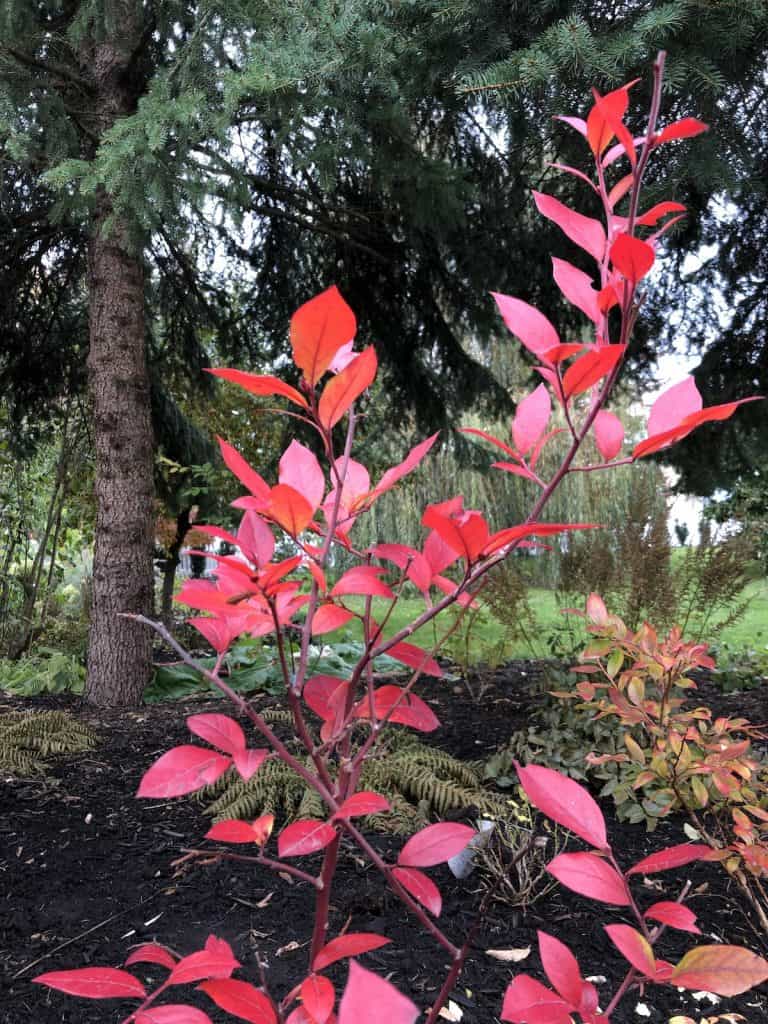
FAQs about blueberry plant leaves turning red
How do you fix red leaves on blueberries?
Blueberry foliage exhibiting reddish hues can be the result of numerous factors, such as the arrival of autumn, nutrient deficiencies, fungal maladies, and environmental distress.
Start by assessing the plant’s environment to ensure it is receiving adequate sunlight and water. Additionally, check for signs of pests or diseases. If necessary, apply an appropriate fungicide or insecticide as directed. Finally, consider adding fertilizer that contains nitrogen and other essential nutrients to help restore balance in the soil.
Do blueberry bushes turn red in the winter?
Yes, blueberry bushes do turn red in autumn before winter. They are not evergreen shrubs and don’t remain green year-round. They have green leaves that appear in spring, stay green through summer, and then turn red in the fall, before falling off in wintertime.
Before you go…
Gardening can be a fulfilling venture, yet it may also come with its own set of troubles. Don’t be alarmed if you observe the foliage of your blueberry shrub turning red. By understanding the causes and diagnosing the problem, you can take steps to treat nutrient deficiencies or address environmental stressors.
Resources
- Companion plants for blueberries (and what not to plant nearby)
- When to fertilize blueberries: Seasonal plant food timing for blueberry bushes
- A gardener’s guide to pruning blueberries
- When to prune blueberry bushes?
- How to prune blueberry bushes?
References
- James, L. (2019). Blueberry Cultivation: A Guide On How To Grow Blueberries. Independently Published.
- Gault, K. S. (2010). The Complete Guide to Growing Your Own Fruits and Berries: Everything You Need to Know Explained Simply (p. 147). Atlantic Publishing Company.
- Beckwith, C. S. (2011). Cranberry and Blueberry Culture – With Information Relating to Growing for Profit. Read Books Ltd.
- University of Minnesota (n.d.). Pest management for home blueberry plants. University of Minnesota Digital Conservancy. https://conservancy.umn.edu/handle/11299/198099
Need more info?
Are you interested in learning more about blueberry plant leaves turning red? Here are our best articles about it!


